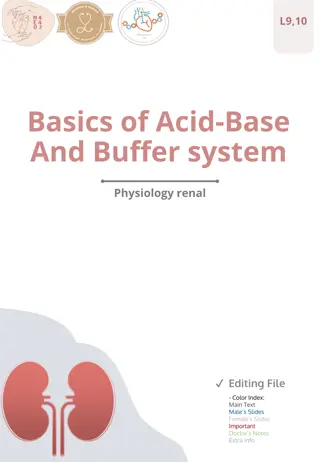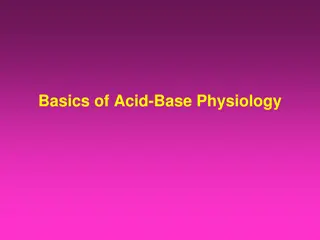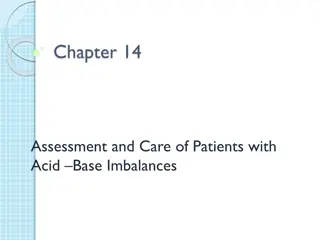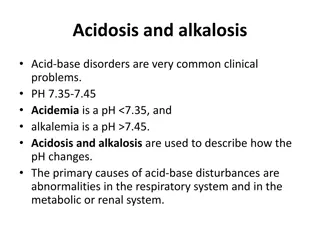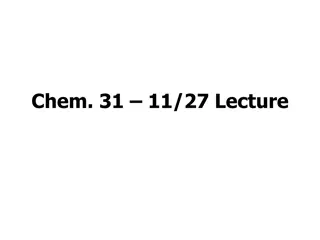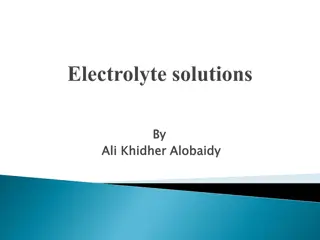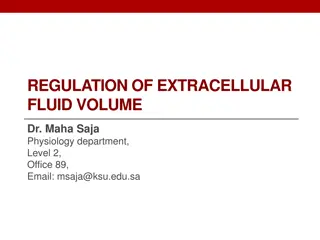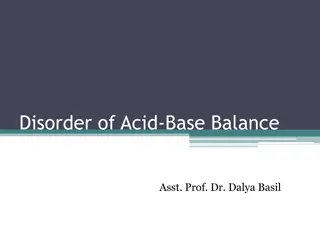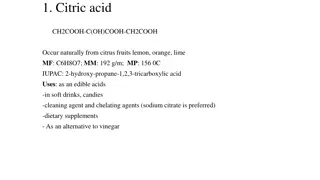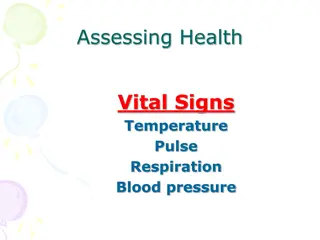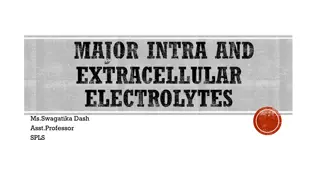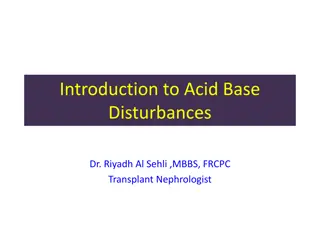Understanding Acid-Base Balance in the Body: Importance and Regulation
Acid-base balance is crucial for maintaining optimal health, as slight deviations in hydrogen ion concentration can impact enzyme activity and metabolic processes. The body employs various defense mechanisms to regulate pH levels, involving buffers, lungs, and kidneys. Strong acids release more H+ ions than weak acids, affecting the pH of body fluids. Understanding the fundamentals of acids, bases, and their dissociation constants is essential for grasping acid-base disturbances and the role of the kidney in maintaining proper pH balance.
Download Presentation

Please find below an Image/Link to download the presentation.
The content on the website is provided AS IS for your information and personal use only. It may not be sold, licensed, or shared on other websites without obtaining consent from the author. Download presentation by click this link. If you encounter any issues during the download, it is possible that the publisher has removed the file from their server.
E N D
Presentation Transcript
ACID-BASE BALANCE Dr. Maha Saja MBBS, MSc Physiology, PhD
Contents What are acids and bases? What is meant by a weak and a strong acid or base? What is the normal pH of body fluids? Why is it important to keep body fluid pH within certain limits? What are the body s defense mechanisms against changes in blood pH: body buffers, the lungs and the kidney. Understand the role of the kidney in regulating pH of body fluids. Acid-base disturbances.
Acid-Base Balance Acid-base balance is concerned with the precise regulation of free (unbound) hydrogen ion (H+) concentration in body fluids. Normally, [H+] = 0.00004 mEq/L (40 nEq/L). Why is it important to control [H+]? (Sherwood L. Human physiology: from cells to systems. 4th ed. 2001; Guyton & Hall. Textbook of medical physiology. 13th ed. )
Why Should [H+] be Tightly Controlled? Slight deviations in [H+] have profound effects on enzyme and protein activity and thus the body s metabolic activity in general. Changes in [H+] affects K+ levels in the body. (Sherwood L. Human physiology: from cells to systems. 4th ed. 2001; Guyton & Hall. Textbook of medical physiology. 13th ed. )
Why is the Bodys [H+] Constantly Changing? A number of processes can alter [H+] concentration in the body, such as; 1. Metabolism of ingested food. 2. GI secretions. 3. Generation of acids & bases from amino acid/protein metabolism. 4. Changes in CO2 production. (Vander s Renal Physiology. 8th ed)
Acid-Base Fundamentals An Acid = a molecule that can release H+ in a solution. H2CO3 (carbonic acid) HCl (hydrochloric acid) A base = a molecule that accepts H+ in a solution. Bicarbonate ions (HCO3-). Hydrogen phosphate (HPO4-2) What is the difference between carbonic & hydrochloric acid?
Strong vs Weak Acids & Bases Strong acids dissociate rapidly and release large amounts of H+ in solution Weak acids dissociate incompletely and less strongly releasing small amounts of H+ in solution
Weak Acids ? + ?+ ?? ????????? ???? + ?+ ???? The extent to which a given acid dissociates in solution is constant. And is known as the dissociation constant (K). ?+[? ] [??] ? = ?+[???? ] [?? ???] ? = ???? + ?+ ?????
[H+] & the pH H+ ion concentrations are expressed as pH. pH = - Log [H+] If the [H+] increase pH will decrease (more acidic) If the [H+] decrease pH will increase (more alkaline) What is the normal pH of the ECF? Normally pH= 7.35-7.45 pH < 6.8 pH > 8 Alkalosis Acidosis pH= 7.35-7.45 Death Death (Guyton & Hall. Textbook of medical physiology. 13th ed. )
pH and H+ Concentration of Body Fluids [H+] (mEq/L) pH Extracellular fluid Arterial blood 4.0 X 10-5 7.4 Venous blood 4.5 X 10-5 7.35 IF 4.5 X 10-5 7.35 Intracellular fluid 1 X 10-3 to 4 X 10-5 6-7.4 Urine 3 X 10-2 to 1 X 10-5 4.5-8 Gastric HCl 160 0.8 (Guyton & Hall. Textbook of medical physiology. 13th ed. )
Acid Production by the Body The body produces large amounts of acids on daily basis as by products of metabolism. Metabolism of dietary proteins. Anaerobic metabolism of carbs and fat. Acids in the body are of two kinds: 1. Volatile (CO2) 2. Non-volatile fixed (sulfuric acid, lactic acid) (daily acid load 50-100 mEq/day) (0.8 mEq/kg/d). (Vander s Renal Physiology. 8th ed ; Guyton & Hall. Textbook of medical physiology. 13th ed. )
The Bodys Defense Against Changes in [H+] Three main systems: 1. Body fluid buffers. Works within seconds. 2. Lungs Works within minutes. 3. Kidneys Works within hours-days. The most powerful of the three.
What is a Buffer? A buffer = a solution that resists changes in pH upon addition of small amount of acids or bases. Acid Base Buffer Buffer Neutralizes small additions of bases/acids pH remains constant
How do Buffers work? A buffer is a mixture of a weak acid and a weak base that are in equilibrium. To be more accurate, its either made of: A weak acid and its conjugated base (H2CO3 & NaHCO3-). A weak base and its conjugated acid (NH3 & NH4+). How does a buffer do its job?
Chemical Buffer Systems in the Body There are 3 chemical buffers in the body; 1. The Bicarbonate buffer system. 2. The phosphate buffer system. 3. Proteins. They are the 1st line of defence against changes in pH i.e. [H+], act within seconds. Some are more powerful extracellularly and others are more powerful intracellularly.
The Bicarbonate Buffer System Composed of: A weak acid (H2CO3). Its conjugated base (NaHCO3). CA CO2 + H2O H2CO3 H+ + HCO3 - NaHCO3 Na+ + HCO3-
The Bicarbonate Buffer System H2CO3 forms in the body by the reaction of CO2 & H2O 1. Carbonic anhydrase CO2 + H2O H2CO3 H2CO3 ionizes weakly to form small amounts of H+ & HCO3- 2. H2CO3 H+ & HCO3- The second component is NaHCO3 which dissociates to form Na+ & HCO3- 3. NaHCO3 Na+ & HCO3-
The Bicarbonate Buffer System Putting it all together; This is the main ECF buffer system What happens if you add a base or an acid to the system?
The Henderson-Hasselbalch Equation What is the HHE? It is an equation that enables the calculation of pH of a solution. What is it? ???? ?.?? ? ???? ?? = ?? + ??? K = dissociation constant, pK = 6.1 0.03 = solubility of CO2
The Henderson-Hasselbalch Equation How was it derived? H2CO3 H+ + HCO3- 1. H2CO3 and its dissociated ions are always in equilibrium the products of the reaction on one side of the equation are proportional to the product on the other side. [H2CO3] [H+ ] X [HCO3-] 2. Since H2CO3 is a weak acid, it will not dissociate completely and the concentration of its products will depend on its dissociation constant (K) K X [H2CO3] = [H+ ] X [HCO3-]
The Henderson-Hasselbalch Equation 3. Based on the previous equation, [H+] can be expressed as follows; H+= ? ?[H2CO3] [HCO3 ] 4. Because H2CO3 can rapidly dissociate into CO2 and H2O. And since CO2 is much easier to measure it can replace H2CO3 in the equation; [C??] [HCO3 ] This is Henderson s equation (1908) H+= ? ? It means that; [CO2] [H+] [HCO3-] [H+]
The Henderson-Hasselbalch Equation 5. In 1909, Sorensen created the pH scale to express [H+ ] ?? = ???[?+] 6. In 1916, Hasselbalch decided to merge Henderson s equation with Sorensen s pH scale creating what we now know as the Henderson-Hasselbalch equation . [C??] [HCO3 ] [???] [???? ] ??? ?+= ??? ? ? H+= ? ?
The Henderson-Hasselbalch Equation [???] [????] ??? ?+= ??? ? ? This is Henderson-Hasselbach equation (1908) ?? = ?? + log[???3] [??2] 7. Since it is much easier to measure PCO2 rather than dissolved [CO2] and because dissolved CO2 is proportional to PCO2 multiplied by the solubility of CO2 (0.03 mmol/mmHg) [CO2] was replaced by PCO2 X 0.03 [???3] 0.03 ? ???2 Ta-Da ?? = ?? + log
The Bicarbonate Buffer System CA CO2 + H2O H2CO3 H+ + HCO3 - [???3 ] 0.03 ? ???2 ?? = ?? + log What do we understand from this equation? Regulated by kidneys HCO3 PCO2 pH 1. Each element of the buffer system is regulated Regulated by lungs HCO3 will pH PCO2 will pH
Summary of the Bicarbonate Buffer System Why is it the most important buffer system in the ECF?
???? ???? Ratio of is 20:1
Other Buffering Systems The phosphate buffer: Plays a major role in buffering intracellular & renal tubular fluid. Composed of; H2PO4- (dihydrogen phosphate) HPO4-2 (Hydrogen phosphate) Proteins: Contributes to buffering inside cells. E.g. Hb.
Summary of Bodys Buffering Systems Buffer systems do not work independently in body fluids but actually work together. A change in the balance in one buffer system, changes the balance of the other systems. Buffers do not reverse the pH change, they only limit it. Buffers do not correct changes in [H+] or [HCO3-], they only limit the effect of change on body pH until their concentration is properly adjusted by either the lungs or the kidney.
RESPIRATORY REGULATION OF ACID-BASE BALANCE
Respiratory Regulation of A/B 2nd line of defence against acid-base disturbances in the body. HOW? By modulating CO2 excretion. [H+] ventilation (RR) PCO2 [H+] ventilation (RR) accumulation of CO2 PCO2. Normally, PCO2 = 40 mmHg (35-45 mmHg)
RENAL REGULATION OF ACID-BASE BALANCE
Renal Regulation of A/B Balance 3rd line of defence against acid-base disturbances and the most powerful. It regulates by excreting either an acidic or basic urine. HOW? 1. Secreting H+ 2. Reabsorbing HCO3- 3. Generating new bicarbonate ions.
Overview HCO3- Reabsorption by the Renal Tubules
How is HCO3-Reabsorbed by the tubules? What happens at the PCT? The PCT reabsorbs, reclaims , 80- 90% of the filtered HCO3-. HCO3- reabsorption is linked to H+ secretion.
What happens at the late DCT & CT? The filtrate arriving at the DCT & CT is low in HCO3-. The distal segments of the nephron are characterised by the presence of intercalated cells capable of actively secreting H+ through H+-ATPase and H+-K+ ATPase present on their apical membrane (Type-A intercalated cells). Only a limited number of H+ can be excreted in its free form in urine. Lowest possible urine pH=4.5 0.04 mmol/L of free H+. How does the kidney excrete the extra H+? (Vander s Renal Physiology. 8th ed)
Non-Bicarbonate Buffers in the Tubular Lumen? The extra H+ secreted will need to be buffered in the tubular lumen 2 main non-bicarbonate buffers in the tubule Synthesized Filtered Ammonia buffer system Phosphate buffer system NH4+ (acid) NH3 + H+ (base) H2PO4- (acid) HPO4-2 + H+ (base)
Excretion of H+ and Generation of New HCO3- The phosphate buffer system Excretion of H+ as phosphate is capable of handling a limited amount of H+ and will not be enough to rid the body of its daily acid load nor if there is unusually high acid production. (Vander s Renal Physiology. 8th ed ; Guyton & Hall. Textbook of medical physiology. 13th ed. )
Excretion of H+ and Generation of New HCO3- The Ammonia Buffer System Renal tubular cells, especially PCT, are capable of generating ammonium (NH4+) ammoniagenesis which is then excreted in urine carrying with it H+. The rate of ammoniagenesis can be modified according to the needs of the body. Quantitatively, the ammonia buffer system is more important than the phosphate buffer system for H+ excretion in urine. It is the most important system in case of acidosis.
The Overall Scheme of Renal Excretion of Acids & Bases To excrete acid: 1. Freely filter HCO3- 2. Reabsorb the majority of filtered HCO3- 3. Reabsorb some additional HCO3- 4. Secrete H+ (titrate filtered bases, i.e. HPO4-2) and secrete NH4+ 5. Excrete acidic urine containing NH4+ 1. 4. 2. 3. To excrete base: 1. Freely filter HCO3- 2. Reabsorb the majority of filtered HCO3- 3. Reabsorb some additional HCO3- 4. Secrete some HCO3- 5. Excrete alkaline urine containing HCO3- 5. (Adapted with modification from Vander s Renal Physiology. 8th ed)
Factors Affecting H+ Secretion and HCO3- Reabsorption


